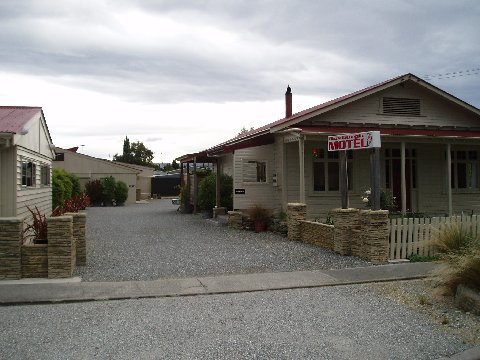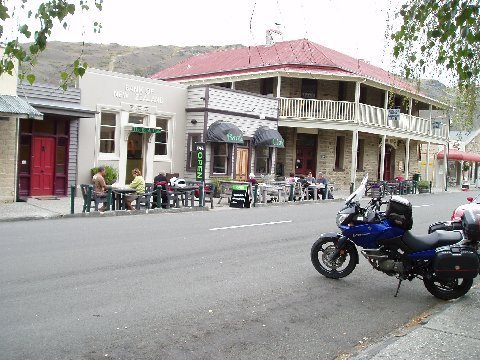Counting down the days too quickly
We gave the Catlins short shrift, I fear, after we found that the beachfront areas could only be reached by gravel roads. The paved road through the area was pretty enough, with low hills and lots of curves and quite a few places where the ocean suddenly came into view as the bike rounded a hillside. (Again, the ocean with completely undeveloped coastline.) We stopped for our mid-morning snack at the “Whistling Frog” café, part of a “holiday park” which catered to camper vans and small camping trailers which are ubiquitous here in New Zealand. We spoke to the manager of the place (and the farm which was part of the same operation) who told us that this had been their best year for quite some time. The weather had been good for farming (i.e. wet) and the tourist trade from Europe, the Orient and the US had increased dramatically. The favorable NZ dollar rate has made it a very popular destination.

(we didn't actually hear any frogs whistling, but it is fun trying to picture how they'd look doing it)
By the time we left the café, the rain had picked up again and the ever-present wind was beginning to become bothersome at times. I missed a turn at the beachfront area of Fortrose (at least there was a road shown on the map which I never saw on the ground….it might have been gravel and unmarked ) and we ended up going on into Invercargill, where, due no doubt to an oversight on the part of the New Zealand tourism commission, there is no center-of-town monument to Burt Munro, and his garage, with its Offerings to the Gods of Speed is not one of the places marked as a “must see”. We did come into town through neighborhoods that looked just like the one in the movie portrayed as his. Lunch was at an old hotel café where we were served by a pleasant young woman who told us she was from TeAnou. When I asked her why she had left such a pretty place to come to an industrial city, she said “because I’ve lived there all my life”. She said she’d probably go back when she got older. It’s the universal human urge to go “somewhere else” and see what’s over the next horizon. As we left town, on roads I’m sure Burt traversed on his Indian, the wind and rain resumed, making travel rather slow. We had decided to go north again, to pick up in our last days here a few of the favorite places we’d visited before. Our leash was growing short, the bike has to be turned in on the 30th, so we can’t get too far out of range of Dunedin. We headed for Wanaka, but made it only as far as Roxburgh that night. As we came back into the mountains of Central Otago, both of noted that this seemed to be the area we most liked. The scenery is still mind-blowing, but not so overwhelming as the craggy mountains of the West Coast where nature isn’t quite as far along in her softening process. Here in Otago, the high hills are again covered in limestone-looking outcroppings and the valleys are deep, with the landscape at times looking like Ireland, other times the north of Yorkshire in England and others, Bavaria. It’s easy to see why peoples from all over the world have come here to settle…for an awful lot of them, it looks like home. At Roxburgh, we found a small motel off the main road, with an unusual parking arrangement. Each unit has its own “garage”, a secluded covered parking area lacking only an outer door to be fully enclosed.

(Even for NZ, a motorcycle-friendly place if ever there was one, this is exceptional)
Inside the unit, there was a bedroom separate from a kitchen/living room, more than adequate for staying extended periods of time. And all this for about US $45. We asked the proprietor about getting a meal. He called the local hotel (here in NZ, “hotel” usually means a combination of pub and restaurant, not always or even typically with any lodging function) and gave us directions to it, just around the corner. When we got there, the publican escorted us back into the dining room which was normally closed for the evening, but opened just for us. He and his wife catered to us in our “private” dining room, with an excellent meal, local beer and wine and charged us the princely sum of about $40 US for the experience. When we expressed our gratitude for such service he replied “We do this all the time”. As I said earlier, this country is set up for people who travel.

The old hotel with the marvelously personal dining service

The Roxburgh Motel
The next morning we left Roxburgh headed north, feeling the pressure of time running out. It’s only a short run from there to Clyde, the small town where we’d spent our first night on the road. We wanted to have “elevenses” (a charming English custom of having a snack at 11 AM, to tide one over til lunch) at our favorite café there. We arrived just about on time, parked in front of the café and strolled over to the outside tables. An older lady sat at one with her morning paper, coffee & pastry and a Border Collie under the bench. The dog, as is typical of her breed, seemed eager but too well trained to do anything out of order. With the owner’s permission I began the pet the animal who let me know that this was exactly the right thing to do. The owner laughed and told me I’d get tired of doing it long before the dog would. She was right. We (Brenda and I, not the dog) went into the café and were greeted by the owner who recalled us from three weeks earlier. She seemed pleased to see us, as though she expected us back like locals. We sat outside on the street, enjoying our wonderful breakfast plates (these folks really understand the concept of breakfast, in my book) and just soaking up as much of the flavor of the town as we could.

(Brenda on the sidewalk in front of the cafe in Clyde. The border collie is under the table behind her)

(The cafe across the street is, I think, our favorite of an overall wonderful lot in NZ)
Back on the bike, we made our way up beside Lake Dunstan toward Wanaka This road had amazed both of us three weeks earlier and it hadn’t diminished a bit. As we left Clyde, the road climbs up the side of the mountain on the east side of the lake, high above the water’s surface, then begins to drop in curves down to just above the shore, though “shoreline” isn’t exactly a good description. The side of the road, to my left (I’m in the left lane, remember) ends and then there is a dropoff of sheer rock about 50 feet down to the surface. I can’t spend a lot of time looking around. At Cromwell, the road crosses the lake and heads up the other side, now in low hills bordered by vineyards and orchards. Here the wind picks up in earnest, causing us to slow to 60 or 80 KmPH just to keep the bike on the road. The wind is a constant feature here in New Zealand and it seems to my non-native view, a somewhat unpredictable feature. It often comes from the direction you don’t expect and then sometimes can change direction 180 degrees without warning. Obviously, the farmers here pay attention to it because they erect large windbreaks that we see often from the bike. At a distance these look like an ordinary box hedge such as you would have around your suburban yard, except when you get closer you see they are 40 feet or more high and 20 feet wide, composed of evergreen trees that are planted so close together that the branches intertwine making a solid barrier. What I don’t know is how they trim them into such perfectly box- like shapes. I can’t imagine a set of hedge clippers that size. These windbreaks can be as much a half mile long beside the road or outlining a field like a fence. We often saw herds of sheep or cattle arranged along the base of these, seeking shelter. On the motorcycle the wind can be a problem. We are constantly banking into it as if going around a curve when we are on a straight stretch of road. When it strikes suddenly as when one comes through a canyon, it can almost upset one’s balance. When going into a head wind its like being battered about the head and shoulders. Going along of the sea coast one can see the wind blowing the water up on shore but the prevailing wind that you are fighting is coming from the opposite direction. I’ve come to expect it somewhat, but it always manages to surprise me. The wind died down as the road got further from the water going into Luggate and making the turn up into Wanaka.